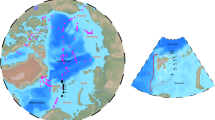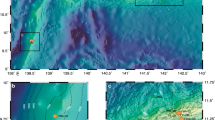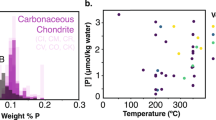Abstract
Chloride—the most abundant ion in sea water1—affects ocean salinity, and thereby seawater density and ocean circulation. Its lack of reactivity gives it an extremely long residence time2. Other halogens are known to be incorporated into marine organic matter3,4,5. However, evidence of similar transformations of seawater chloride is lacking, aside from emissions of volatile organochlorine by marine algae6,7,8. Here we report high organochlorine concentrations from 180 to 700 mg kg−1 in natural particulate organic matter that settled into sediment traps at depths between 800 and 3,200 m in the Arabian Sea, taken between 1994 and 1995. X-ray spectromicroscopic imaging of chlorine bonding reveals that this organochlorine exists primarily in concentrated aliphatic forms consistent with lipid chlorination, along with a more diffuse aromatic fraction. High aliphatic organochlorine in particulate material from cultured phytoplankton suggests that primary production is a source of chlorinated organic matter. We also found that particulate algal detritus can act as an organic substrate for abiotic reactions involving Fe2+, H2O2 or light that incorporate chlorine into organic matter at levels up to several grams per kilogram. We conclude that transformations of marine chloride to non-volatile organochlorine through biological and abiotic pathways represent an oceanic sink for this relatively unreactive element.
This is a preview of subscription content, access via your institution
Access options
Subscribe to this journal
Receive 12 print issues and online access
$259.00 per year
only $21.58 per issue
Buy this article
- Purchase on Springer Link
- Instant access to full article PDF
Prices may be subject to local taxes which are calculated during checkout




Similar content being viewed by others
References
Chester, R. Marine Geochemistry 2nd edn (Blackwell, 2003).
Wentworth, C. K. A scale of grade and class terms for clastic sediments. J. Geol. 30, 377–392 (1922).
Thunell, R. C., Moore, W. S., Dymond, J. & Pilskaln, C. H. Elemental and isotopic fluxes in the Southern California Bight: A time-series sediment trap study in the San Pedro Basin. J. Geophys. Res. 99, 875–889 (1994).
Wong, G. T. F., Brewer, P. G. & Spencer, D. W. The distribution of particulate iodine in the Atlantic Ocean. Earth Planet. Sci. Lett. 32, 441–450 (1976).
Elderfield, H. & Truesdale, V. W. On the biophilic nature of iodine in seawater. Earth Planet. Sci. Lett. 50, 105–114 (1980).
Baker, J. M. et al. Emissions of CH3Br, organochlorines, and organoiodines from temperate macroalgae. Chemosphere—Glob. Change Sci. 3, 93–106 (2001).
Nightingale, P., Malin, G. & Liss, P. Production of chloroform and other low-molecular-weight halocarbons by some species of macroalgae. Limnol. Oceanogr. 40, 680–689 (1995).
Scarratt, M. G. & Moore, R. M. Production of methyl bromide and methyl chloride in laboratory cultures of marine phytoplankton II. Mar. Chem. 59, 311–320 (1998).
Fowler, S. W. & Knauer, G. A. Role of large particles in the transport of elements and organic compounds through the oceanic water column. Prog. Oceanogr. 16, 147–194 (1986).
Honjo, S., Manganini, S. J., Krishfield, R. A. & Francois, R. Particulate organic carbon fluxes to the ocean interior and factors controlling the biological pump: A synthesis of global sediment trap programs since 1983. Prog. Oceanogr. 76, 217–285 (2008).
Muir, D. C. G., Norstrom, R. J. & Simon, M. Organochlorine contaminants in arctic marine food chains: Accumulation of specific polychlorinated biphenyls and chlordane-related compounds. Environ. Sci. Technol. 22, 1071–1079 (1988).
Galban-Malagon, C. J., Del Vento, S., Berrojalbiz, N., Ojeda, M. J. & Dachs, J. Polychlorinated biphenyls, hexachlorocyclohexanes and hexachlorobenzene in seawater and phytoplankton from the Southern Ocean (Weddell, South Scotia, and Bellingshausen Seas). Environ. Sci. Technol. 47, 5578–5587 (2013).
Borgå, K., Fisk, A. T., Hoekstra, P. F. & Muir, D. C. G. Biological and chemical factors of importance in the bioaccumulation and trophic transfer of persistent organochlorine contaminants in arctic marine food webs. Environ. Toxicol. Chem. 23, 2367–2385 (2004).
Repeta, D. J., Hartman, N. T., John, S., Jones, A. D. & Goericke, R. Structure elucidation and characterization of polychlorinated biphenyl carboxylic acids as major constituents of chromophoric dissolved organic matter in seawater. Environ. Sci. Technol. 38, 5373–5378 (2004).
Gribble, G. W. Naturally occurring organohalogen compounds—A comprehensive update. Prog. Chem. Org. Nat. Prod. 91, 1–613 (2010).
Leri, A. C., Mayer, L. M., Thornton, K. R. & Ravel, B. Bromination of marine particulate organic matter through oxidative mechanisms. Geochim. Cosmochim. Acta 142, 53–63 (2014).
Reina, R. G., Leri, A. C. & Myneni, S. C. B. Cl K-edge X-ray spectroscopic investigation of enzymatic formation of organochlorines in weathering plant material. Environ. Sci. Technol. 38, 783–789 (2004).
Leri, A. C., Hay, M. B., Lanzirotti, A., Rao, W. & Myneni, S. C. B. Quantitative determination of absolute organohalogen concentrations in environmental samples by X-ray absorption spectroscopy. Anal. Chem. 78, 5711–5718 (2006).
Madhupratap, M. et al. Mechanism of the biological response to winter cooling in the northeastern Arabian Sea. Nature 384, 549–552 (1996).
Lee, C. et al. Particulate organic carbon fluxes: Compilation of results from the 1995 US JGOFS Arabian Sea Process Study: By the Arabian Sea Carbon Flux Group. Deep-Sea Res. II 45, 2489–2501 (1998).
Berelson, W. The flux of particulate organic carbon into the ocean interior: A comparison of four US JGOFS regional studies. Oceanography 14, 59–67 (2001).
Honjo, S., Dymond, J., Prell, W. & Ittekkot, V. Monsoon-controlled export fluxes to the interior of the Arabian Sea. Deep-Sea Res. II 46, 1859–1902 (1999).
Andruleit, H., Rogalla, U. & Stäger, S. Living coccolithophores recorded during the onset of upwelling conditions off Oman in the western Arabian Sea. J. Nannoplankton Res. 27, 1–14 (2005).
Méndez-Díaz, J. D. et al. Sunlight-driven photochemical halogenation of dissolved organic matter in seawater: A natural abiotic source of organobromine and organoiodine. Environ. Sci. Technol. 48, 7418–7427 (2014).
Calza, P., Massolino, C., Pelizzetti, E. & Minero, C. Role of iron species in the photo-transformation of phenol in artificial and natural seawater. Sci. Total Environ. 426, 281–288 (2012).
Pignatello, J. J., Oliveros, E. & MacKay, A. Advanced oxidation processes for organic contaminant destruction based on the Fenton reaction and related chemistry. Crit. Rev. Environ. Sci. Technol. 36, 1–84 (2006).
Dembitsky, V. M. & Srebnik, M. Natural halogenated fatty acids: Their analogues and derivatives. Prog. Lipid Res. 41, 315–367 (2002).
Winterbourn, C. C., van den Berg, J. J., Roitman, E. & Kuypers, F. A. Chlorohydrin formation from unsaturated fatty acids reacted with hypochlorous acid. Arch. Biochem. Biophys. 296, 547–555 (1992).
Neilson, A. H. An environmental perspective on the biodegradation of organochlorine xenobiotics. Int. Biodeter. Biodegr. 37, 3–21 (1996).
Berner, E. K. & Berner, R. A. Global Water Cycle: Geochemistry and Environment (Prentice Hall, 1987).
Acknowledgements
The authors are grateful to C. Lee of Stony Brook University for providing sediment trap samples. Use of the National Synchrotron LightSource (NSLS), Brookhaven National Laboratory, was supported by the US Department of Energy, Office of Science, Office of Basic Energy Sciences, under Contract No. DE-AC02-98CH10886. S. Khalid, N. Marinkovic and R. Tappero provided assistance at the NSLS. A.C.L. is supported by the Marymount Manhattan College Distinguished Chair award.
Author information
Authors and Affiliations
Contributions
A.C.L. and L.M.M. conceived and designed the experiments. K.R.T. carried out treatments of fresh microalgae. A.C.L. prepared samples for X-ray analysis and collected, processed and interpreted the data. P.A.N. provided technical assistance at NSLS beamline X15B. M.R.D. and K.J.N. collected X-ray data. A.B.G. performed optical microscopy. A.C.L. prepared the figures and wrote the paper, with contributions and edits from L.M.M., who provided useful input at all stages.
Corresponding author
Ethics declarations
Competing interests
The authors declare no competing financial interests.
Supplementary information
Supplementary Information
Supplementary Information (PDF 620 kb)
Rights and permissions
About this article
Cite this article
Leri, A., Mayer, L., Thornton, K. et al. A marine sink for chlorine in natural organic matter. Nature Geosci 8, 620–624 (2015). https://doi.org/10.1038/ngeo2481
Received:
Accepted:
Published:
Issue Date:
DOI: https://doi.org/10.1038/ngeo2481
This article is cited by
-
Chlorine redox chemistry is widespread in microbiology
The ISME Journal (2023)
-
Geochemical properties of blue carbon sediments through an elevation gradient: study of an anthropogenically impacted coastal lagoon
Biogeochemistry (2023)
-
Novel Chloroflexi genomes from the deepest ocean reveal metabolic strategies for the adaptation to deep-sea habitats
Microbiome (2022)
-
Organohalide-respiring Desulfoluna species isolated from marine environments
The ISME Journal (2020)



